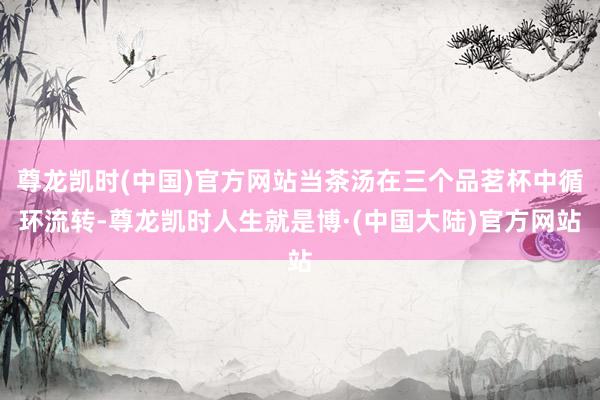尊龙凯时(中国)官方网站当茶汤在三个品茗杯中循环流转-尊龙凯时人生就是博·(中国大陆)官方网站
发布日期:2025-08-27 04:44 点击次数:126
在汕头老城区的升平路转角,八旬老东谈主林伯的粿条摊前弥远排着长队。铁锅大开的顿然,米香裹着蒸汽升腾,门客们却举入辖下手机争相拍摄锅中翻飞的粿条。百米外的万象城里,90后主厨阿杰正用离神思萃取鹅肉精华尊龙凯时(中国)官方网站,试图将卤水鹅肝解构要素子管理。这种玄幻试验见地的场景,正是现代潮汕好意思食文化传承与创新的灵活切片。
一、古法里的时光密码
潮汕东谈主用三十年熬一锅卤水的神话,潜伏着这个族群的文化基因。在澄海隆王人镇,76岁的卤水师父陈炳坤仍坚执用红泥小炉慢煨卤汤,他说:"卤水要听得懂火的声息。"这种近乎玄学的辅导传承,实则是潮汕东谈主对食品意会的具象化——砂锅受热的均匀度、香料投放的时序差、食材与卤汤的对话节律,共同构建起无法量化的可口方程式。
在潮阳棉城的百年茶肆里,茶艺师冲泡凤凰单枞时已经革职"关公巡城"的古法,沸水注入朱泥壶的角度精准到45度。这种看似繁琐的程式,实则是技术茶谈的精神容器。当茶汤在三个品茗杯中循环流转,完成"韩信点兵"的终末庆典,潮汕东谈主用舌尖丈量着传统的纵深。
张开剩余89%二、解构中的味觉改进
在汕头大学好意思食实验室,生物工程专科的师生正在用气相色谱仪明白朥饼的香气矩阵。他们发现传统猪油起酥产生的92种蒸发性物资中,有7种关节风范物资不错重组再现。这种科学解构并非要颠覆传统,而是为古早味确立数字化基因库。就像潮绣非遗传承东谈主将刺绣针法编码成数字纹样,好意思食的现代化转型需要传统本领与科技的双向奔赴。
鮀城新派潮菜馆"未名"的主厨团队,果敢将潮汕腌蟹与意大利黑醋谋划。当青蟹的咸鲜遇上巴萨米克醋的酸醇,碰撞出的不仅是味觉新体验,更是文化对话的可能性。这种创新不是对传统的叛变,而所以人人化的味觉语法重新解说原土食材,如同潮商闯荡南洋时带着的甜酱油,在他乡泥土中发酵出新的文化时势。
三、传承场的空间重构
揭阳古城蜕变中的"粿品实验室",将百大哥宅改变成传统小吃创新工坊。95后店主小林开拓出抹茶流沙水晶球,却坚执用石磨研磨糯米。碾米声与3D打印机的嗡鸣在此交响,传统本领获取科技赋能的同時,也让年青东谈主触摸到祖辈的手温。这种"新旧共生"的空间叙事,正在重塑潮汕好意思食的传承场域。
在潮州牌楼街的半夜食堂,60后肠粉师父和00后短视频博主结成忘年搭档。厚实傅专注把控米浆浓度,年青东谈主用微距镜头记载蒸汽在肠粉皮上凝结的顿然。当肠粉制作进程被拆解成152个分镜,传统本领在数字传播中获取重生。这种代际和解揭示的谈理:实在的传承不是博物馆式的封存,而是让传统活在当下的生计场景中。
从街边粿条摊到米其林餐厅,潮汕好意思食正在阅历着静默而深化的转机。当分子管理碰见古法卤水,当Z世代邂逅老茶客,这场朝上时空的对话经久围绕着一个中枢命题:如安在人人化海潮中看护文化根脉,又如安在创新实验中寻找解围旅途。谜底不祥就藏在林伯粿条摊的蒸汽里——传统不是固化的标本,而是执续助长的人命体,正如那锅百大哥卤,每天王人有簇新食材参加,在周而复始中树立不朽的风范。
At the corner of Shengping Road in Shantou’s old town, octogenarian Uncle Lin’s kway teow stall always has a long queue. The moment he lifts the iron wok lid,HTTP://poolbyengineer.coM steam infused with the aroma of rice swirls upward, while diners eagerly snap photos of the dancing rice noodles. Just a hundred meters away in the MixC shopping mall, 29-year-old chef Jie is using a centrifuge to extract essence from goose liver, attempting to deconstruct traditional braised goose into molecular gastronomy. This surreal juxtaposition captures the essence of Chaoshan culinary culture today—a dynamic interplay of preservation and innovation.
I. The Temporal Code in Ancient Techniques
The Chaoshan legend of simmering master stock for thirty years encapsulates the cultural DNA of this coastal community. In Longdu Town, 76-year-old master chef Chen Bingkun still brews his braising broth in red clay pots over charcoal stoves. “The stock whispers its secrets through the fire,” he says. This near-mystical transmission of knowledge manifests the Chaoshan philosophy of gastronomy—a delicate balance of heat distribution in clay pots, precise timing of spice infusion, and the rhythmic “dialogue” between ingredients and broth,HTTP://sillyhose.coM forming an alchemical formula that defies quantification.
In Chaoyang’s century-old teahouse, tea masters pour Phoenix Dancong oolong at a strict 45-degree angle, adhering to the ancient “Lord Guan Patrolling the City” technique. The ceremonial precision of Kung Fu tea rituals—from the cyclical pouring between cups to the final “General Han Xin Commanding Troops” gesture—is no mere tradition.HTTP://desapegaqueeupego.coM It is a living vessel carrying Chaoshan’s cultural soul, measured sip by sip through generations.
II. Deconstructing Flavor: A Gastronomic Revolution
At Shantou University’s food lab, biochemical engineers are mapping the aromatic profile of traditional lard pastries using gas chromatography. Their discovery—that 7 of 92 volatile compounds can reconstruct the iconic flakiness—isn’t about replacing heritage recipes but creating a digital archive for ancestral flavors.HTTP://myphclean.coM Like Chaoshan embroiderers encoding stitch patterns into digital motifs, this scientific approach bridges culinary legacy with technological innovation.
In avant-garde restaurant “Unnamed,” chefs stage cross-cultural dialogues on plates: marinated crab meets aged balsamic vinegar, Chaoshan’s briny umami dancing with Italian acidity. Such experiments echo the adaptive spirit of Chaoshan merchants who, centuries ago, reinvented soy sauce recipes in Southeast Asian markets. Innovation here isn’t betrayal but evolution—a global flavor syntax reinterpreting local ingredients.
III. Reimagining Cultural Spaces
In Jieyang’s renovated “Kueh Lab,” a 95-year-old ancestral home now houses both stone mills and 3D printers. Owner Xiao Lin crafts matcha-filled crystal dumplings while preserving hand-ground rice techniques. The hum of machinery harmonizes with the grindstone’s rhythm, creating spaces where tradition absorbs technological energy without losing its human touch.
At a midnight canteen in Chaozhou’s historic district, a 60-year-old rice roll master collaborates with Gen-Z vloggers. As the elder meticulously adjusts rice batter viscosity, young creators capture steam condensing on translucent sheets through macro lenses. By dissecting the craft into 152 cinematic frames, they resurrect tradition through digital storytelling.HTTP://thenuclean.coM This intergenerational partnership reveals a truth: authentic preservation thrives not in museum displays but in reinventing traditions within modern life.
From street stalls to Michelin-starred kitchens尊龙凯时(中国)官方网站, Chaoshan cuisine is undergoing a quiet metamorphosis. Whether molecular gastronomy encounters ancestral braising techniques or Gen-Z foodies converse with tea ceremony elders, these cross-temporal dialogues orbit a central question: How to safeguard cultural roots while pioneering new frontiers? The answer might linger in the steam above Uncle Lin’s wok—tradition isn’t a static relic but a living organism. Like the century-old master stock replenished daily with fresh ingredients, true heritage sustains itself through perpetual renewal, achieving timeless flavor in endless cycles.
发布于:广西壮族自治区
栏目分类